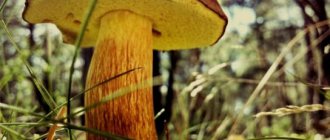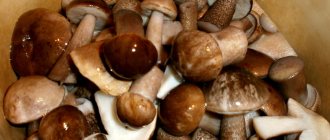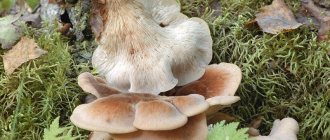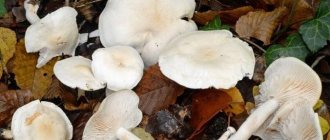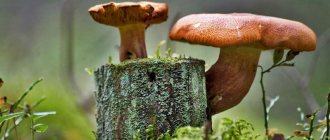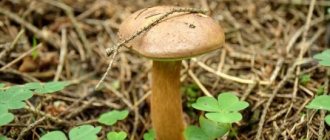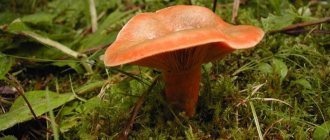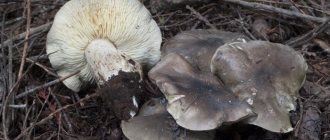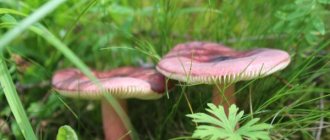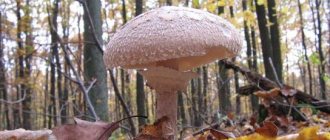The podgrudok mushroom is edible. The cap is 5-15 cm, convex at an early age, with a tucked edge, later in the form of a saucer, concave, fleshy, brittle, mucous when wet. The mushrooms are glossy, gray-whitish, then smoky brown. The plates are straw-yellow, frequent. The leg is whitish, hard, 4-8 cm long and 2-4 cm thick, at first solid, then hollow. The pulp is white, gray-reddish when cut, not pungent. There is no milky juice. Spore powder is white.
Mushroom loading (photo)
In the photo there is a Podgruzdok mushroom
Grows in coniferous forests, especially under pine trees, on sandy soil.
Fruits from July to October. Found singly or in small groups.
The black loader has no doubles. See what the loader looks like in the photo and read the description about it below in the article:
These mushrooms can be found in almost all forests of Russia: both coniferous and deciduous. They usually grow in groups, which mushroom pickers really like. They hide under the leaves, so you need to look for them and dig them out.
Among its edible qualities, the mushroom is also popular for its medicinal properties. It is actively used in pharmacology for the manufacture of various medications, as well as in folk medicine.
Podgrudok belongs to the Russula family. Found in forests from June to November. They come in several types:
The appearance of the load is similar to that of a milk mushroom. The similarities are visible in the shape of the cap. But it does not have fringed edges, is matte white or with spots of a brownish tint, and is dry. Its size is no more than 20 cm in diameter. The fashion of the mushroom is distinguished by the presence of a dent on the cap at the top, and the adult one has funnels. The pulp is brittle. The plates of this type of mushroom are often white, sometimes they can have a bluish tint.
Let's take a closer look at all the types of loading presented, see photos later in the article.
Description
Podgruzdok has the taste, aroma and description that real milk mushrooms have.
Product Features:
- the surface of the cap is pleasant to the touch, dry and velvety;
- a hat without fringe at the edges (milk mushrooms must have such a fringe);
- reaches a height of 20-22 cm;
- young individuals have funnel-shaped caps;
- the lamellar part has a bluish tint;
- the pulp is brittle;
- a low, hard, cylinder-shaped leg (5-7 cm in height and up to 4 cm in diameter).
White spore powder. There is no juice, like in milkweeds, the flesh at the break remains white.
Lovers of podgruzdki collect them in deciduous forests, in coniferous forests, the collection time is from July to October. The smoky, whitish-brown caps hide deep beneath the leaf litter at the base of trees. You will have to work hard to find them.
They grow in small families. Worms and forest parasites do not like them, so the harvest can be harvested unharmed.
White load (dry load)
In the photo Podgruzdok is white
The white podgruzdok (dry milk mushroom) has a short and thick stem. It is white in color. The older the mushroom, the more likely it is that the stem will be hollow in the middle.
The russula mushroom has a cap with a diameter of 7 to 20 cm, a pure white shade, and dry. Often has attached lumps of earth or leaves. The plates are white and thin. Their shade can be blue or slightly greenish. The pulp is dense, white. Does not change color when scrapped. The plates are white, caustic.
The white loader is similar in appearance to a violin. A significant difference is the absence of milky juice. Look what the white loader looks like in the photo:
This species is used in cooking, fried, for mushroom broths, pickled and salted. Alcohol tinctures are also prepared on fruiting bodies and used to treat sarcomas and carcinomas.
Application
Loading agents are widely used in various spheres of human life: in cooking, medicine, pharmaceuticals and dietetics.
In cooking
Mushrooms contain more phosphorus than fish.
Cooks enjoy using different types of them for preparing salty snacks and pickling. Soups with this product have a bright, pronounced taste and aroma.
In the Volga region they like to salt the podgrudki in a dry way and use such preparations all winter.
Mushrooms with onions, sour cream, fried in sunflower or olive oil, are served both as a main dish and as a side dish for meat or fish.
In medicine and pharmaceuticals
Scientists have isolated ellagic acid from black fat. Its derivative, isolated in 2004, was named nigrikacin. It is a powerful anticancer agent and is used in the treatment of cancer. In addition, it was found that the mushroom contains substances with antioxidant and antibacterial properties.
To suppress the growth of Ehrlich carcinoma, use an extract of white pods infused with alcohol at a dosage of 300 mg/kg.
These forest organisms have high antimicrobial properties, which are used to create medicinal ethanol extracts. This remedy is effective against gram-positive bacteria and viruses. For your information. Bacteria whose cells are stained using the method developed by the Danish microbiologist H.K. Gram are called gram-positive.
In traditional Chinese medicine, nigella is used for cramps to relax muscles.
A large amount of protein and antioxidants help lower blood sugar, so the products are recommended for patients with diabetes.
Frequent plate loading
In the photo, Frequently plate loading
Another name for this species is common nigella. It is found more often in the south of Russia, in coniferous, mixed or deciduous forests.
The cap is distinguished by a more grayish, sometimes brown tint, which becomes olive and sometimes brown in color as the fungus grows. Its diameter is rarely more than 12 cm. Young mushrooms have a sticky cap, but with age it becomes dry. The leg is the same shade as the cap.
When scrapped, the pulp turns red, then brown, and then turns black. This mushroom has light plates that do not reach its stem.
The taste is inexpressive, the smell is weak.
In medicine, an extract from a frequent-plate loading is used. It has antimicrobial activity. To relax muscles, the properties of this type of mushroom are used in medicine.
In the kitchen, loaded plates are often fried, made into broths, marinated and salted. The mushroom does not need to be pre-boiled.
Aspen milk mushroom
Aspen (or poplar) milkweed is found singly or in small groups in damp aspen or poplar forests. It is collected in July - September.
The cap of this milk mushroom is off-white in color, with brownish or pinkish spots and darker concentric zones. Pink plates. The leg is dense, short, white.
Aspen milkweed (Lactarius controversus)
The pulp is pungent in taste, with a pungent odor, and pink in color.
This mushroom belongs to category II. Traditionally it is salted.
Podgrudok blackening: photo and description
In the photo Podgruzdok is turning black
The blackening mushroom has a cap up to 20 cm. As it grows, it changes its shade from whitish brown, and in the old mushroom it becomes black. The plates are white, sometimes yellowish, but as they grow older they also become dark. They are quite rarely located from each other.
The flesh of the body is hard, quite dense, and when reacting with air changes its color to dark. The mushroom tastes pleasant, not hot. The leg of the black species is solid and acquires a brown tint.
Look at this loading mushroom in the photo:
From the description of its main differences from other subspecies, it is clear that its distinctive feature is its dark color, which gave it its name.
It can most often be found in the temperate forest zone of Russia from July to October. Loves the soil under coniferous and deciduous trees.
Contraindications
Mushrooms are contraindicated for gastrointestinal problems
These forest organisms accumulate excessive amounts of chitin. There is especially a lot of it in the legs. Because of this, this product is considered difficult to digest, and therefore people suffering from diseases of the gastrointestinal tract should use it with caution.
When harvesting, it is important to adhere to simple rules, for example, do not collect loads near busy highways, populated areas, landfills or factories. Mushrooms are natural sponges and absorb all harmful substances from the environment: exhaust gases, radionuclides, etc. When consuming crops collected in dangerous places, severe poisoning occurs, similar to poisoning from poisonous mushrooms.
For elderly people, pregnant women and young children, it is better to eat “forest meat” in moderation and after consulting a doctor.
Black podgrudok mushroom
The black podgrudok differs from the blackening one mainly only in the shade of the pulp on the cut. It turns red. Its taste and other qualities remain similar.
In pharmacy it is used as an antioxidant and antisarcoma agent. Nigrikacin is obtained from it.
The mushroom is used for food in fried, salted or pickled form. It is also suitable for making soups.
Podgrudok, a description of the species of which we have provided you with, are quite frequent guests in the forests of our territory. They grow under foliage or needles and reveal their presence only by small tubercles above the ground. Mushroom pickers love these mushrooms for their taste.
| Name: | Loader blackening |
| Latin name: | Russula nigricans |
| Type: | Conditionally edible |
| Synonyms: | Russula blackening |
| Characteristics: |
|
| Taxonomy: |
|
Podgrudok blackening belongs to the Russula family. In appearance it resembles a milk mushroom. This variety and other dark mushrooms are combined into one group. A characteristic feature of the representatives is the black color of the pulp.
Edible mushrooms and their types
There are a lot of edible mushrooms in nature—thousands of species. The most delicious are champignons, white mushrooms, oyster mushrooms, saffron milk caps, and butter mushrooms. To this list it is worth adding Caesar mushrooms, greenfinches, honey mushrooms, boletuses, boletus mushrooms, russula, umbrella mushrooms and others. Many of them are delicacies, such as the Caesar mushroom, which grows on the Mediterranean coast.
There are conditionally edible types of mushrooms. These include volushki, milk mushrooms, value mushroom, oak mushroom, bitter mushroom, common morel, dung beetle and others. These gifts of the forest, after heat treatment, lose the toxic properties inherent in them in their raw form. It is advisable to use young mushrooms for food, after boiling them in a large amount of water for at least 40 minutes. As a result of this treatment, all bitter and caustic toxic substances will be removed.
Edible mushrooms are a storehouse of useful substances. Next, we’ll talk about the black podgruzda – a bright representative of the Russula family.
Where do the blackening pods grow?
The species forms a mycelium near hardwood trees. Mushrooms live in coniferous, deciduous, and mixed forests. The preferred habitat region is Western Siberia and temperate Russia. They can also be found in broad-leaved, spruce thickets. Blackening podgrudok is common in Western Europe and Asian countries.
It grows mainly in small groups. Fruiting is long-lasting, beginning in mid-summer and ending at the end of October. According to the observations of mushroom pickers, mushrooms grow even in cold areas, for example, on the Korean Isthmus. In the Leningrad region they appear in August.
Distribution and fruiting season
Russula black prefers to grow in various forests of the northern temperate climate zone - coniferous, deciduous or mixed. The main partner tree is pine, but the fungus also develops well under birch trees and is often found in forest clearings or along roads and paths. Grows both in splendid isolation and in the company of fellow creatures.
The fruiting period is long, starting in mid-summer, in July, and lasting until severe frosts (until October).
What do blackening loads look like?
On average, the diameter of the cap varies from 5 to 15 cm. However, there are large specimens with a size of the upper part of more than 25 cm. When they appear, young mushrooms have a white cap; over time, the color becomes dirty gray or brown. There are brown fruiting bodies with an olive tint. In the center the cap is dark gray, lighter at the edges. The photos correspond to the description of the loading blackening.
The surface is dry, only in humid weather there is a small amount of mucus on the skin. On the first day after appearance, the shape of the cap is spherical, later it becomes flat. Shallow pits are visible in the center. There are often cracks on the surface of the cap, through which the white flesh is visible.
The plates are large and thick. Rarely located. In young mushrooms they are white, while in old ones they have a gray, brownish-pink tint. There are atypical specimens with black plates.
The height of the leg is 10 cm. The structure is dense, the color is white. The shape is cylindrical. As it grows, the leg also acquires a dirty gray tint.
The pulp of the blackening podgruzdka is thick, but fragile. The composition includes iron sulfate, which upon contact with air oxidizes and turns the cut pink. The taste is slightly bitter, the aroma is weak, pleasant.
Russula blackening
The cap is 8-10 (20) cm in diameter, densely fleshy, convex, then flat-spread, slightly depressed, with a sharp, smooth edge. The skin is adherent, initially sticky, then dry, bare, smooth, matte when dry, grayish-brown, almost black. The plates are attached, sparse, thick, wide, forked, with plates and anastomoses, white, cream, turning black with age. The stem is 2-6 x 1-3 cm, cylindrical, initially hard, then brittle, made or with cavities, bare, smooth or thin felt, colored a tone lighter than the cap. The pulp is fragile, loose, white, reddens and then blackens in the air, tastes fresh, soft, without much odor. When exposed to FeSO4, it turns dark green. Spore powder is white.
Habitat: deciduous, coniferous and mixed forests. It occurs from July to October. Grows in groups.
The cap is up to 15 cm in diameter, convex at first, depressed in a mature mushroom, with curved edges, dirty gray, then brown or black, sticky. The pulp is white, brittle, without milky juice, turns red when broken or cut, then turns brown and finally turns black. The taste is sweetish.
The plates are adherent to the stem or descending, white, and darken when pressed. Spore powder is white.
The leg is up to 5 cm long, 2.5-3 cm thick, smooth, dense, the same color as the cap.
A little-known edible of the third category. Used boiled and salted. When salted it turns black. Very damaged by insects.
And blackening: description of the mushroom and what the mushroom looks like in the photo
For active growth of the plant, a lot of light and a small amount of heat are required. This mushroom grows in huge quantities in the deciduous and mixed forests of the central zone of our country. Usually its mycelium dislocations are located near aspen and birch trees. It is these trees that create the most favorable conditions for their existence.
Podgruzdok among the people has a simpler name. This is a dry milk mushroom. It is not by chance that the mushroom is called this way. Unlike ordinary ones, they never become covered with mucus and do not become wet. The surface of their caps is always dry and slightly rough to the touch.
A regular loader looks the same. This is a fairly strong cap with inwardly curved edges with a diameter of up to 20 cm. The upper surface of the cap is matte white with yellowish inclusions. As the mushroom grows, it is prone to cracking. A characteristic feature is the absence of milky juice on the cut of the stem and cap. Podgruzdok or dry milk mushroom belongs to the second category of edibility. It can be used for salting without first soaking in water
Loader black or black
From the beginning of July until the very end of October, the coniferous and deciduous forests of our country can please you with a rich harvest of another variety of dry milk mushroom. This is a black loader. It is also called black russula. And this is no coincidence. Externally, the black loader really resembles a russula. The cap is up to 15 cm in diameter and has a glossy surface of dark blue, almost black color. There is no milky juice.
Black podgrudok can be used as food in boiled, fried and salted form. Does not require soaking for direct use.
Pogruzdok white and mushroom cracker
Podgrudok white and mushroom cracker are the names of the same specimen. This is a variety of milk mushrooms and lamellar mushrooms, which are found in large numbers in bright places in deciduous forests. They can be used for food without prior boiling and soaking. They are distinguished by the absence of bitterness and unpleasant taste. belong to the category of little-known. But don't neglect them. They contain a fairly large amount of protein and various active substances that improve digestion processes. Dry milk mushrooms make excellent mushroom powder for sauces and seasonings.
What does a blackened boot load look like?
Podgrudok blackening is another type of agaric mushroom that is found by mushroom pickers in mixed and deciduous forests and remains unnoticed. Many people confuse them with poisonous and inedible due to their unsightly appearance. But let's try to figure it out.
There is a definite opinion among mushroom pickers that lamellar mushrooms must secrete milky juice. Dry milk mushrooms do not have milky juice. And this does not mean that it is poisonous. The blackened milk mushroom in appearance resembles a real milk mushroom. But unlike it, with the passage of time, its cap and leg begin to acquire a black color. Old specimens are almost black in all parts.
Benefits and harms
The blackening pulp contains:
- vitamins E, PP, F, B1, B2;
- mono- and disaccharides, dietary fiber;
- saturated, unsaturated acids;
- microelements: sodium, phosphorus, iron, calcium, potassium, magnesium.
Mushrooms are a nutritious and dietary product. They have anti-inflammatory and antibacterial properties. Helps improve metabolic processes in the body.
It should be remembered that mushrooms, if prepared incorrectly, can cause heaviness, pain, and disruption of the gastrointestinal tract. People with stomach problems are not advised to use them. Heavy foods can be dangerous for older people who still have diseases of the liver, kidneys, gall bladder, and immunity.
Even edible varieties can cause trouble if there is an individual sensitivity. A person may have an acute reaction to a specific type of mushroom. It is not recommended for children under 12 years of age, pregnant and lactating mothers to eat blackened pogrudok.
Beneficial features
Loading agents have a lot of beneficial properties that are important for the human body, due to their chemical composition, which includes the following important elements:
- vitamins of group B, A, P and PP;
- zinc;
- copper;
- manganese;
- ergosterol;
- amino acids;
- cellulose;
- stearic acid;
- chitin.
Vitamins strengthen the body and support it during viral epidemics. The amino acids that make up proteins serve as a natural barrier against bacteria. Fiber contributes to normal intestinal function.
Collection rules
It is best to go mushroom picking early in the morning. It is at this time that the lighting mode is optimal. It is necessary to know the characteristics of the mushrooms being collected. In a new forest, in a different climate, the country is better off collecting under the supervision of a local mushroom picker. Familiar species may turn out to be poisonous counterparts. A mistake can lead to fatal consequences.
The terrain is of no small importance. It is not recommended to collect blackening loads in forest belts near highways, cemeteries, fertilized agricultural fields, and chemical industry enterprises.
When picking mushrooms, it is important to pay attention to the shape, color of the cap, color and smell of the pulp, characteristic features, and soil. This will help identify the poisonous species.
Podgrudok blackening is capable of growing in the substrate. After a few days it appears on the surface and breaks the top layer. The soil is cracking in this area. Another feature of the type is its slow decomposition under natural conditions. In the process, the fruiting body darkens. A dried specimen can be preserved until next season.
After returning from the forest, a mandatory step is sorting the crop. It is then that suspicious and dangerous species are cut off.
Cooking methods
Peeled podgrudki can be fried, stewed and even baked, having previously been prepared in the manner described above. The cooking time and the use of additional ingredients depend on the requirements of the chosen recipe, but in any case, do not forget about the peculiarities of cooking the harvested crop.
Important! It is advisable to freeze mushrooms in portions so that you do not have to defrost the entire amount each time. When re-frozen, they lose much of their benefits.
Sometimes the preparation of mushrooms ends at this stage, and the process itself consists of several stages:
- Cleaning blackening loads from debris.
- Soak them in clean and cold water for three days, replacing the liquid every 24 hours.
- Thorough cleaning of soaked specimens from the skin and darkened or yellowed areas (simply cut off with a knife).
- Cook the mushrooms in a saucepan over moderate heat with the addition of a teaspoon of salt (the water should completely cover the fruiting bodies). As soon as the loads boil, they need to be boiled for another 20 minutes and then removed from the heat.
- Rinsing the mushrooms after draining the boiling water and cooling them (should be done in cold water so that the mushrooms do not darken).
- Mixing with spices and salt in a separate container (the amount of required ingredients is determined depending on the number of mushrooms and the volume of the pan).
Ready-made boiled toppings can either be further used for culinary purposes (for example, for frying or stewing), or frozen in the freezer, thereby preparing for the future.
An equally successful way to preserve mushrooms for a long time is to pickle them. As in the first case, there is nothing complicated in this process, especially if you choose a quick version of such a workpiece. In addition to the blackening russula itself, water and salt, you will also need citric acid, which improves the taste of the finished product.
The salting process is based on the following steps:
- To begin with, the collected mushrooms should be thoroughly cleaned of dirt and needles, cut off all blackened and yellowed areas, and then boil over low heat in accordance with the method described above.
- After they have been boiled for 20 minutes, you need to add a pinch of citric acid to the pan and after boiling for three minutes, remove the loads from the heat (they should cool in a container with cold water).
- While the mushrooms are cooling, start preparing the brine, calculating 2 tbsp for each liter of water. spoons of salt.
- Transfer the loading into an airtight jar, fill with brine and place in a container with cold water.
As soon as the mushrooms have cooled and soaked a little in the brine, they can be eaten. In terms of taste, the blackening mushroom is not inferior to other popular mushrooms, of course, if you choose the youngest and most worm-free mushrooms for cooking.
False doubles loading blackening
Due to inexperience, a mushroom picker may confuse the blackening mushroom with false toadstool, which is a poisonous mushroom. To prevent this from happening, you should know the main features of a false double.
Pale grebe - spherical or flat type of cap. Color green, light gray, olive. The plates are frequent, small, white in color. The leg is high. It has a thickening at the base. The color is beige. The surface is covered with a mesh pattern. The flesh of the pale toadstool is light and does not change color when cut.
The blackening load has harmless doubles. They will not cause harm, and a joint tandem will be a delicious dish on the table.
- The loader is white and black. It has a whitish cap with a gray tint. The plates are thick. The flesh is light, but immediately turns black when cut. They grow in birch and aspen groves. The fruiting period begins in autumn. Rarely seen.
- Loader black. It is characterized by an external resemblance to the blackening load. You can distinguish mushrooms from each other by the color of their flesh. The cut of the black mushroom has a brown tint and is covered with spots. Settles in coniferous forests.
Blue breast
This milk mushroom has another name, and it’s quite offensive - dog milk mushroom. Why he was given such a nickname, no one can answer: dogs don’t seem to eat him, and in appearance there is also nothing similar to our four-legged friends. But as for turning blue, everything is clear here. This is due to the purple tint of the records and the same color of the juice. Purple, blue - for us this color is always suspicious, which is most likely associated with various kinds of bruises, swelling, and lights under the eyes. Probably for this reason, many mushroom pickers avoid this milk mushroom, considering it something like a toadstool. But in vain! This is a very good, edible category II mushroom.
Blue breast (Lactarius repraesentaneus)
This mushroom is quite rare. It can be found in deciduous, coniferous and mixed forests in moist areas of soil with a thick layer of fallen leaves.
The shape of the cap is similar to a real milk mushroom, and the color resembles yellow. And only the plates are colored in their own way. Its pulp is dense, white, and bitter. The leg is up to 3 cm thick and up to 7 cm long, pale yellow, loose inside. When ripe, it is hollow. When you press it it turns blue.
The mushroom is tasty when salted. It is of some value from a medical point of view, as it is a strong antibiotic, helping in the treatment of abscesses and sore throats.
Blackening Podgruzdok (Russula nigricans)
Russula blackening
Blackening Podgrudok is a type of mushroom included in the genus Russula and belongs to the Russula family.
It has a cap from 5 to 15 centimeters (sometimes larger specimens are found - even up to 25 centimeters in diameter). At first the cap is whitish in color, but then becomes dirty grayish, brown with a soot-colored tint. There are also brownish specimens with an olive tint. The middle of the cap is darker, and its edges are lighter. On the cap there are adhered particles of dirt, earth, and forest debris.
Treatment
First of all, the collected mushrooms need to be cleaned of adhering twigs, leaves and other forest debris. Then you should remove the skin from the cap (pre-soaking the caps in clean water will help make the task easier) and clean the stem thoroughly, cutting it in several places to prevent worms in each specimen.
Peeled and cut fruiting bodies (it is advisable to immediately divide into parts only large specimens) all that remains is to rinse well under running water and place in a pan for heat treatment. For further preparation, the mushrooms are boiled in two stages (20 minutes each), each time filling the loading with clean water.
White-black russula (Russula albonigra)
or
Russula white and black
White-black russula (Russula albonigra) - belongs to the genus Russula, included in the Russula family. The following names of the mushroom are also found: Pogruzdok black and white, Russula white and black, Chernushka white and black. The mushroom has an interesting minty flavor to the pulp.
The white-black russula has a cap with a diameter of seven to twelve centimeters. At first the flesh is convex, but then has a rolled edge. As the mushroom develops, the cap flattens and becomes concave. The color of the cap also changes - from white with a dirty tint to brown, almost black. It has a matte, smooth surface. Usually it is dry, only in humid weather - sometimes sticky. Often, various forest debris can stick to such a hat. The skin is easily removed from the cap.
The plates of this mushroom are narrow and frequent. As a rule, they are of different lengths, often ending in a short stem. The color of the plates is initially white or slightly creamy, and then they gradually turn black. Spore powder is white or light cream in color.
The white-black russula has a small stalk - from three to seven centimeters. Its thickness is up to two and a half centimeters. It is smooth, dense, cylindrical in shape. As the mushroom matures, it gradually turns black.
This mushroom has a dense, hard stem. If the mushroom is young, then it is white, but then becomes darker. The smell of mushroom is weak and indefinite. But the taste is soft and has a slight minty note. Sometimes you may come across specimens with a sharper taste.
White-black russula grows in many forests - coniferous and deciduous. Growing time is from July to early October. But it is quite rare in the forests of Europe, Asia and North America.
It is classified as an edible mushroom, but its taste is rather mediocre. According to some Western researchers, it is still inedible or even poisonous. The fungus can cause gastrointestinal disorders.
Similar species
- Podgrudok blackening - Compared to the white-black one, this is a larger mushroom. It does not have such frequent plates, and the flesh turns red and then turns black when cut.
- Podgruzdok (russula) often plate-shaped - Quite often found in our forests. It has the same frequent plates, and the flesh when cut also changes its color from light to dark and black. But the pulp of this mushroom has an unpleasant burning taste.
- Black russula - The pulp of this mushroom is pleasant to the taste, and it also turns black when cut. The plates of this mushroom are frequent and dark in color.
Such mushrooms, together with the white-black mushroom, are included in a special group of blackening mushrooms. This is due to the characteristic behavior of the pulp when cut, because it changes its color to black without going through the so-called brown stage. And if you act on the pulp of the mushroom with iron sulfate, the color changes are completely different: first it becomes pink, and then acquires a green tint.
Recipes
It is better to salt pig mushrooms using a hot method with frying (we do not recommend salting pig mushrooms using a cold method).
For preparations, use only coarse table salt without iodine content.
Traditional pickling recipe
This is a simple recipe, but only in terms of the amount of ingredients - you will need a minimum of them. But with mushrooms you will have to work hard, since they require serious preliminary preparation: soaking and triple boiling. Using this method, you can salt pigs for the winter in large quantities.
Number of servings/volume: 2.5-3 l
Ingredients:
- fresh pigs – 3 kg;
- rock salt – 150 g;
- dill with umbrellas – 8-10 pcs.;
- black currant leaves – 10 pcs.;
- garlic – 8-10 cloves;
- black peppercorns – 10-15 pcs.
Preparation:
- Wash the pigs, cut off any suspicious fragments, cut the medium-sized mushrooms into 2 parts.
- Place the mushrooms in a container/basin, cover with cold water and leave for 16-18 hours. Change the water 4-5 times.
- Drain the liquid, pour the soaked pigs with salted water, put on the fire, wait until it boils and boil for 10 minutes.
- Drain the first water and pour a new portion of salted water over the mushrooms, but this time cooking will take 30 minutes from the moment it boils.
- Repeat the process again. The third time, the mushrooms are cooked for 45 minutes.
- Wash the dill and blackcurrant leaves, cut the peeled garlic into slices.
- Place dill umbrellas and currant leaves on the bottom of sterilized jars.
- Place the mushrooms in a sieve or colander and let the water drain.
- Place the pigs into jars, sprinkling them in layers with salt, pepper and garlic slices.
- Boil clean water and fill the jars to the very top.
- Place a pressure in each of them: a regular glass filled with water will do.
- The jars are kept indoors at room temperature until completely cooled, and then sent to a cold place - a cellar or refrigerator.
- After 45 days, the pickles are ready.
Bon appetit!
Pickling recipe: hot method with frying
It is somewhat labor-intensive, but after such processing you can eat pork without fear for your health. In addition, thanks to frying, the taste of mushrooms becomes more intense, so pickling this method is very popular.
Number of servings/volume: 3 l
Ingredients:
- fresh pigs – 4 kg;
- table salt – 8 tbsp. l.;
- garlic – 3-4 medium-sized heads;
- vegetable oil – enough for frying;
- bay leaf – 10-15 pcs.;
- black peppercorns – 10 pcs.;
- allspice peas – 10 pcs.
Preparation:
- Rinse young pigs thoroughly and soak them in cold water for 48 hours. Change the water at least 4 times a day.
- After 2 days, drain the water and rinse the mushrooms.
- Pour salted water into a saucepan and cook them after boiling for about an hour and a half. Don't forget to skim off the foam.
- Drain the water and repeat the process. Cooking time for the second time is 45 minutes.
- Drain the mushrooms in a colander and allow excess liquid to drain.
- Wash the seasonings, peel the garlic and chop it into a paste.
- Place the pigs in a deep enough frying pan, pour in enough oil to cover them completely.
- Add spices and salt, mix everything.
- Fry the mixture for about 45 minutes, stirring occasionally.
- Place the finished mushrooms in clean, dry, sterilized jars and cover with nylon lids.
- Leave in the room until completely cooled, then transfer to the cellar or put in the refrigerator.
- The first sample can be taken within a day.
Enjoy the taste, bon appetit!
How to deliciously cook milk mushrooms
Hot salting of real milk mushrooms
- The first step is to select other types of mushrooms from the milk mushrooms. Rinse everything several times with water. Use an old toothbrush to remove dirt and treat the surface. We trim the legs and leave to soak for a day. In this case, the water changes 3-4 times during this time. Place the peeled mushrooms in a bucket.
- Transfer the mushrooms to a large container. Now we make the brine: for 1 liter of water, 3 large tablespoons of salt. Mix everything and pour over our mushrooms. We wait for everything to boil, after 5 minutes we throw everything into a colander. At the same time, we put the brine with which the jars are filled, all in the same proportion. Turn everything off, let the water drain and the mushrooms cool.
- For pickling we use peppercorns, garlic cloves, and dill umbrellas. We take 0.5-0.7 liter jars, for one jar 3 peppercorns and 2 cloves of garlic. Stack the seasonings to leave room for the brine. Cut large mushrooms into 2-3 parts. Place the mushrooms on top of the seasonings, and then add a layer of seasonings. Fill everything with brine and leave overnight. In the morning you need to top up, as the amount of brine will decrease. Cover with a plastic lid, everything will be ready in 2-3 months.
Crispy marinated milk mushrooms
- To prepare the brine, we need mustard, paprika, garlic, spring grass and black currant leaves. You need dill, horseradish, salt, sugar and bay leaf. For pickling, it is better to choose small milk mushrooms. One kg of mushrooms needs to be boiled to remove the bitterness. After boiling, cook the mixture for 10-15 minutes, do not forget to skim off the foam. All bitterness will go away.
- Place the mushrooms in a colander and rinse them with boiling water.
- We prepare the brine for 1 liter: 3 peppercorns, a sprig of dill, 3 bay leaves, 5 black currant leaves, 5 spring leaves.
- Now put it on the fire and wait until it boils, add 2 tbsp. l salt and 2 tbsp. spoons of sugar. The brine is boiling.
- At the bottom of the jar we put chopped horseradish leaves, 2 cloves of garlic, and 1 tsp. mustard and a pinch of paprika, a sprig of dill. Then lay out a layer of mushrooms halfway, then add horseradish leaves, a sprig of dill, 2 cloves of garlic and continue laying the mushrooms.
- Cover everything with horseradish, dill, 1/3 tsp. mustard and a clove of garlic. Pour the mixture with boiling solution. We put the jars in a dark place, and after a day we place them in the pantry.
Also read: Edible, poisonous and inedible mushrooms of the Moscow region in June
How to fry milk mushrooms (video)
Milk mushrooms in batter
Wash, peel, beat and sprinkle generously with salt. Then leave for 3-4 hours and cook in batter. Cut the mushrooms into pieces. We will make the batter using mineral water: 2 eggs, 300 g of mineral water and 300 g of flour and a pinch of salt. Mix everything. We will fry with enough oil in a deep frying pan.
Milk mushrooms do not have poisonous copies; all representatives of the Milk mushrooms are conditionally edible. You should read about their differences before taking a walk in the woods.
Podgruzdok
|
Black milk mushroom: preparation and recipes
Black milk mushroom, the preparation of which cannot be called simple, is considered a delicacy in many countries, and is preferred by most people. Black milk mushrooms have been in demand at different times, as they are salted and served at various festivals. In past centuries, salting was carried out not in glass containers, as it is now, but in large barrels. Black milk mushrooms got their name due to their external characteristics, as they are quite weighty and massive.
The black milk mushroom is distinguished by its weight and massiveness.
There are several types of this fungus on the territory of the Russian Federation, namely:
- yellow;
- pepper;
- oaky;
- aspen;
- black.
They grow in flocks, and therefore are very easy to collect. Particularly large harvests can be harvested after prolonged heavy rains.
General information about milk mushrooms
Before cooking, the milk mushrooms are thoroughly cleaned.
200 years ago, milk mushrooms were considered the main dish on the table, as they were a meat substitute. Milk mushrooms are a heavy food with a high calorie content, which is why digestion takes much longer (compared to meat products). Mushrooms such as milk mushrooms should not be added to the diet.
At different times, housewives gave preference to salted mushrooms, although in fact various dishes are prepared from them. The breast is a mushroom that is perfect for any feast and family dinner. Milk mushrooms are salted, fried, stewed, and added to soups, casseroles and salads. In a word, it is important to use a little imagination and use only edible, peeled mushrooms.
In order to properly cook milk mushrooms, they should be scalded with salted water, then allowed to drain and left to cool. Then the product is placed in barrels, jars or tubs. An oak barrel would be an excellent option, but if you don’t have such utensils, an enamel pan will do. Add salt to the milk mushrooms to your liking, but do not forget that excess salt can spoil their taste. As a rule, 30 g of salt is added to 1 kg of mushrooms. It is worth adding a little allspice, bay leaf, currant leaf, cloves and dill to the pickling. Pickled mushrooms need to be pressed down.
In order for the food to bring only benefits, it is worth collecting milk mushrooms correctly, that is, avoiding places near factories and highways.
Milk mushroom, like any mushroom, is considered a product that can absorb toxins, and therefore one should not forget about long-term soaking.
Return to contents
Recipe for black salted mushrooms
Salt is the main preservative ingredient.
In order to make black salted milk mushrooms, you should prepare:
- a bucket of mushrooms;
- 100 g salt;
- 100 g sugar;
- cherry and currant leaves;
- Bay leaf;
- garlic - 0.5 kg;
- dry dill.
Mushrooms are cleaned, washed and soaked in cool water for 24 hours. Soaking is carried out so that all the bitterness and harmful components come out of the mushrooms. After soaking in water, the mushrooms are cooked for at least 20 minutes on the stove. As soon as the mushrooms have cooled, finely chopped garlic, dill and other ingredients are added to them. The entire mass should be compacted tightly into a container and placed in a cool place. It is there that this preparation will be ready for use in a week, and before serving it is important not to forget to add a little vegetable oil. An excellent appetizer suitable for any feast, holiday and various celebrations.
Return to contents
How to fry milk mushrooms?
Cooking milk mushrooms removes the bitterness from them.
Fried mushrooms are very tasty. Blue milk mushrooms are considered the best, and when pickled they are stored for a long time, they can be left for the winter. Pickled milk mushrooms can be used for consumption, but without additional processing, such as frying. You can fry this product, but only after the correct procedures.
For consumption, it is important to clean the mushrooms, carefully examine the caps and stems for the presence of rot and parasites in order to exclude them from the total mass. If you encounter a large mushroom, it is important to clean each plate and scrape the cap. All mushrooms are placed in a pan and cooked for half an hour. After this, you should drain the broth, cool the product and look through all the mushrooms. If there are too large species, then they should be boiled for another 20 minutes, or before the first cooking, cut them all equally. This process removes bitterness and makes milk mushrooms softer. The mushrooms should be small at the end of cooking to make them easier to handle when frying. The milk mushrooms go into the frying pan, and then you should add the onions. The amount of onion depends on the preference of the cook, but it is worth remembering that the more onions, the softer the mushrooms will be. The onions are grated and placed in a frying pan, and after a while it is worth adding sour cream, dill, salt and garlic. After 10 minutes of stewing under the lid, the dish is ready to eat, and this dish is eaten both cold and hot.
This side dish would be an excellent option for meat, fish and vegetables. Some people add lard, cut into small pieces, to these mushrooms.
Return to contents
How to make milk mushroom soup?
Before eating, mushroom soup is seasoned with herbs.
What recipes for milk mushroom dishes should you choose? Many people prefer soups. In order to cook the soup, you will need:
- potato;
- mushrooms;
- onion;
- fresh herbs;
- garlic;
- sour cream.
The mushrooms are peeled, washed, and boiled in salted water for about 8 minutes. Separately, it is worth preparing boiling water, cutting the potatoes, adding everything to the pan and boiling for another 10 minutes. The onion is cut, peeled and sautéed with oil in a frying pan. After the onion, pepper and bay leaf are added, everything is cooked for about 10 minutes, and then poured into plates for consumption.
It is worth noting that it is much easier to salt milk mushrooms than to fry them, since it is in such an environment that this product will become soft and tasty. After opening a container with pickled mushrooms, you should not be afraid of their cherry hue, since they acquire exactly this color after contact with salt.
You can and should cook and fry mushrooms, but only after pre-processing. If there is some doubt as to whether all milk mushrooms are edible, you can add an onion during cooking. If it remains light, then the product is suitable for consumption and does not pose a danger.
1pogribam.ru
Similar species and how to distinguish them from them
This load in the world of mushrooms has several doubles, or rather, representatives of this kingdom, very similar to it. It can be confused with the blackhead (Russula nigricans), from which the hero of the article differs in a darker cap and a moldy smell, as well as more frequent plates. When damaged, the flesh of the double does not first turn red, but immediately turns black.
This mushroom can also be confused with the black-purple russula (Russula atropurpurea), which can sometimes acquire almost the same skin color as the black russula. It can be distinguished by the absence of a black spot in the middle of the cap, as well as by its less saturated color than the black-purple one.
